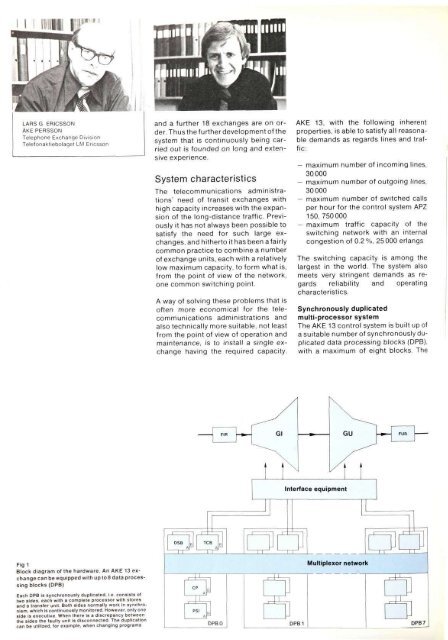Selection and Testing of Electronic Components for LM
Selection and Testing of Electronic Components for LM
Selection and Testing of Electronic Components for LM
Create successful ePaper yourself
Turn your PDF publications into a flip-book with our unique Google optimized e-Paper software.
LARS G ERICSSON<br />
AKE PERSSON<br />
Telephone Exchange Division<br />
Telefonaktiebolaget <strong>LM</strong> Ericsson<br />
Fig 1<br />
Block diagram <strong>of</strong> the hardware. An AKE 13 exchange<br />
can be equipped with up to 8 data processing<br />
blocks (DPB)<br />
Each DPB is synchronously duplicated, i.e. consists <strong>of</strong><br />
two sides, each with a complete processor with stores<br />
<strong>and</strong> a transfer unit. Both sides normally work In synchronism,<br />
which Is continuously monitored. However, only one<br />
side Is executive. When there Is a discrepancy between<br />
the sides the faulty unit Is disconnected. The duplication<br />
can be utilized, <strong>for</strong> example, when changing programs<br />
<strong>and</strong> a further 18 exchanges are on order.<br />
Thus the further development <strong>of</strong> the<br />
system that is continuously being carried<br />
out is founded on long <strong>and</strong> extensive<br />
experience.<br />
System characteristics<br />
The telecommunications administrations'<br />
need <strong>of</strong> transit exchanges with<br />
high capacity increases with the expansion<br />
<strong>of</strong> the long-distance traffic. Previously<br />
it has not always been possible to<br />
satisfy the need <strong>for</strong> such large exchanges,<br />
<strong>and</strong> hitherto it has been a fairly<br />
common practice to combine a number<br />
<strong>of</strong> exchange units, each with a relatively<br />
low maximum capacity, to <strong>for</strong>m what is,<br />
from the point <strong>of</strong> view <strong>of</strong> the network,<br />
one common switching point.<br />
A way <strong>of</strong> solving these problems that is<br />
<strong>of</strong>ten more economical <strong>for</strong> the telecommunications<br />
administrations <strong>and</strong><br />
also technically more suitable, not least<br />
from the point <strong>of</strong> view <strong>of</strong> operation <strong>and</strong><br />
maintenance, is to install a single exchange<br />
having the required capacity.<br />
AKE 13, with the following inherent<br />
properties, is able to satisfy all reasonable<br />
dem<strong>and</strong>s as regards lines <strong>and</strong> traffic:<br />
— maximum number <strong>of</strong> incoming lines,<br />
30000<br />
— maximum number <strong>of</strong> outgoing lines,<br />
30 000<br />
— maximum number <strong>of</strong> switched calls<br />
per hour <strong>for</strong> the control system APZ<br />
150, 750 000<br />
— maximum traffic capacity <strong>of</strong> the<br />
switching network with an internal<br />
congestion <strong>of</strong> 0.2 %, 25 000 erlangs<br />
The switching capacity is among the<br />
largest in the world. The system also<br />
meets very stringent dem<strong>and</strong>s as regards<br />
reliability <strong>and</strong> operating<br />
characteristics.<br />
Synchronously duplicated<br />
multi-processor system<br />
The AKE 13 control system is built up <strong>of</strong><br />
a suitable number <strong>of</strong> synchronously duplicated<br />
data processing blocks (DPB),<br />
with a maximum <strong>of</strong> eight blocks. The
















